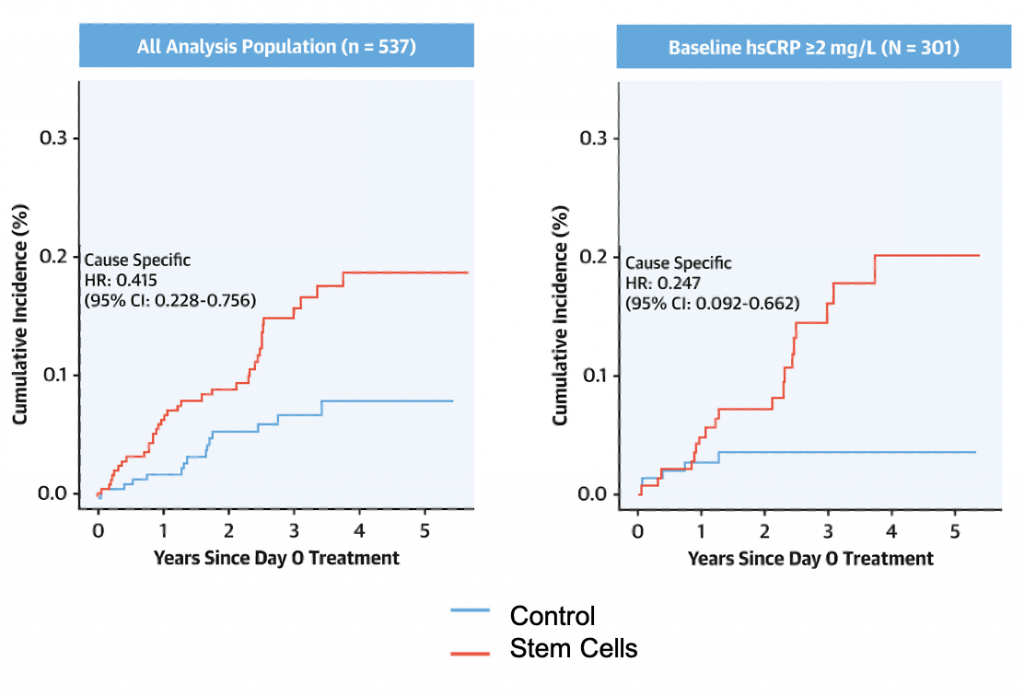Key Points:
- Stem cells from the bone marrow of healthy donors improves the heart pumping function (left ventricular ejection fraction) of patients with heart failure.
- The incidence of stroke or heart attack is reduced by 58% in heart failure patients treated with stem cells.
The most common cause of heart failure (HF) — when the heart cannot efficiently pump blood — is a heart attack, which typically occurs in older individuals. Standard drug treatments for HF do not restore heart function but rather keep the heart from pumping too much. However, the latest clinical trial suggests that heart function can be restored with stem cell therapy.
Researchers from the Texas Heart Institute report in the Journal of the American College of Cardiology that stem cell therapy improves heart function in heart failure patients and reduces the risk of stroke and heart attack. These benefits are more pronounced in patients with high levels of inflammation.
“The Texas Heart Institute has spent two decades pioneering the development of cellular therapies for the heart and continues to lead the world in this breakthrough work. For millions of people in the United States over the age of 20 who suffer from heart failure, [stem cell] therapy could change the future of cardiovascular care for patients with heart failure due to inflammation,” according to Dr. Joseph G. Rogers, President of The Texas Heart Institute.
Stem Cell Therapy Improves Heart Function
As part of the DREAM-HF clinical trial, 283 HF patients (aged 62.7 ± 10.9 years) were given stem cell therapy and 282 (aged 62.6 ± 10.4) a non-stem cell sham therapy. The stem cells (bone marrow mesenchymal progenitor cells) were donated from healthy adults and injected through a small catheter into the damaged regions of HF patient hearts.
The HF patients included in the study possessed a specific type of HF called systolic HF, or HF with reduced ejection fraction. These HF patients exhibit disrupted heart function, as measured by reduced left ventricular ejection fraction (LVEF), indicating reduced blood volume ejected from the heart with each beat.
Using an echocardiogram, which uses soundwaves to visualize the heart, the researchers found that the LVEF was improved following 12 months of stem cell therapy. This effect was driven by patients with high levels of high sensitivity C-reactive protein (hsCRP), a marker of inflammation used in the clinic to predict stroke and heart attack incidence.

After stem cell treatment, the participants of the study were followed over the course of years to determine the incidence of stroke and heart attack (myocardial infarction). It was found that HF patients who underwent stem cell therapy had a 58% decrease in risk of occurrence of heart attack or stroke. In patients with high hsCRP, stem cell therapy reduced the risk of heart attack or stroke by 75%, suggesting that inflammation is a key driver of heart attack and stroke.

DREAM-HF is the largest clinical trial of stem cell therapy for HF patients with reduced ejection fraction to date, pushing forward the applicability of stem cell therapy. Notably, adverse effects were comparable across control and treatment groups, demonstrating the safety of this stem cell therapy.
“The results of DREAM-HF are an important step in understanding how cell therapy provides benefits in patients with chronic heart failure due to poor pump function. The cells appear to work by reducing inflammation, increasing microvascular flow, and strengthening heart muscle,” according to the study’s lead author, Dr. Emerson C. Perin, MD, PhD.
Is Reducing Inflammation the Key to Slowing Aging?
Chronic low-grade inflammation is thought to contribute largely to the aging process. This has led to the coining of the term “inflammaging,” as inflammation seems to underly nearly all age-related diseases, including heart disease. The DREAM-HF study supports this notion and takes it a step further by showing that stem cell therapy can deter inflammaging. Clinical trials are in the works for the stem cell treatment of other age-related diseases, such as Alzheimer’s and type 2 diabetes, suggesting that stem cell therapy may be a true anti-aging therapy of the future.